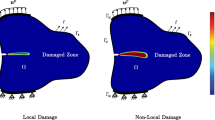Abstract
An approach to determine the crack growth direction under mixed-mode loading conditions is presented. The plastic zone shape around the crack tip is applied for evaluating angle of crack propagation. It is proposed that a mixed-mode crack will extend along the plastic zone radius with a minimum value. The prediction of the proposed criterion is compared with the experimental data and other models. The agreement is fairly good.
Similar content being viewed by others
References
Boniface, V. and Simha, K.R.Y. (1991). A plastic zone model of mixed mode fracture. International Journal of Fracture 48, R9–R12.
Chambers, A.C., Hyde, T.H. and Webster, J.J. (1990). Mixed mode fatigue crack growth at 550ºC under plane stress conditions in jethete M1152. 44, 39–42.
Eftis, J. and Subramonian, N. (1978). The inclined crack under biaxial load. Engineering Fracture Mechanics 10, 43–67.
Erdogan, F. and Sih, G.C. (1963). On the crack extension in plates under plane loading and transverse shear loading. Journal of Basic Engineering ASME Transactions. 85, 519–525.
Finnie, I. and Saith, A. (1973). A note on the angled problem and directional stability of crack. International Journal of Fracture 9, 484–486.
Golos, K. (1988). Fracture energy criterion for fatigue crack propagation. Archiwum Budowy Maszyn 35, 5–16.
Golos, K., Osinski, Z. and Wasiluk, B. (1996). Mixed mode (I+II) model of fatigue crack growth. Mechanisms and Mechanics of Damage and Failure ECF 11(Edited by J. Petit), EMAS 2, 1107–1112.
Hellen, T.K. and Blackburn, W.S. (1975). The calculation of stress intensity factors for combined tensile and shear loading. International Journal of Fracture 11, 605–617.
Iida, S. and Kobayashi, A.S. (1969). Crack propagation rate in 7075-T3 plates under cyclic tensile and transverse shear loading. Journal of Basic Engineering ASME Transactions 91, 519–525.
Irwin, G.R. (1975). Transaction American Society of Mechanical Engineers. 79, 361–364.
Irwin, G. (1958). Handbook of Physics 6, 551–590.
Li, C. (1989). Vector CTD criterion applied to mixed mode fatigue crack growth. Fatigue Fracture Engineering Material Structures 12, 59–65.
Muskhelishvili, N.I. (1963). Some Basic Problems of the Mathematical Theory of Elasticity.4th Edn. Noordhoff Groningen.
Paris, P.C. (1965). The fracture mechanics approach to fatigue. Proceedings of the 10th Sagamore ConferenceSyracuse University Press, 104.
Paris, P.C. and Sih, G.C. (1964). Applied fracture mechanics. ASTM STP 381, 249–278.
Pook, L.P. (1971). Engineering Fracture Mechanical 3, 205–218.
Rice, J.R. (1967). Mechanics of crack tip deformation and extension by fatigue. Fatigue Crack Propagation ASTM STP 415, 247–309.
Seibi, A.C. and Zamrik, S.Y. (1997). Prediction of crack initiation direction for surface flaws under biaxial loading. '97 Poland 2, 611–622.
Sih, G.C. (1974). Strain energy density factor applied to mixed mode crack problems. International Journal of Fracture 10, 305–321.
Shlyannikov, V.N. and Braude, N.Z. (1992). A model for predicting crack growth rate for mixed mode fracture under biaxial loads. Fatigue Fracture Engineering Material Structure 15, 825–844.
Swedlow, J.L. (1976). Criterion for growth of the angled crack. Crack and Fracture ASTM STP 601, 506–521.
Theocaris, P.S. and Andrianopoulos, N.P. (1982). The T-criterion applied to ductile fracture. International Journal of Fracture 20, 125–130.
Williams, M.L. (1957). On the stress distribution at the base of a stationary crack. Journal of Applied Mechanics 24, 109–114.
Wu, X. and Li, X. (1989). Analysis and modification of fracture criteria for mixed mode crack. Engineering Fracture Mechanics 34, 55–6.
Author information
Authors and Affiliations
Rights and permissions
About this article
Cite this article
Golos, K., Wasiluk, B. Role of plastic zone in crack growth direction criterion under mixed mode loading. International Journal of Fracture 102, 341–353 (2000). https://doi.org/10.1023/A:1007663728926
Issue Date:
DOI: https://doi.org/10.1023/A:1007663728926




